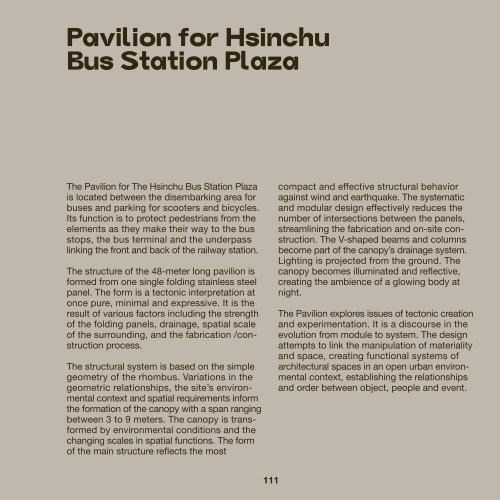Infinity Ground : Thailand and Taiwan Contemporary Architecture
You also want an ePaper? Increase the reach of your titles
YUMPU automatically turns print PDFs into web optimized ePapers that Google loves.
Pavilion for Hsinchu<br />
Bus Station Plaza<br />
The Pavilion for The Hsinchu Bus Station Plaza<br />
is located between the disembarking area for<br />
buses <strong>and</strong> parking for scooters <strong>and</strong> bicycles.<br />
Its function is to protect pedestrians from the<br />
elements as they make their way to the bus<br />
stops, the bus terminal <strong>and</strong> the underpass<br />
linking the front <strong>and</strong> back of the railway station.<br />
The structure of the 48-meter long pavilion is<br />
formed from one single folding stainless steel<br />
panel. The form is a tectonic interpretation at<br />
once pure, minimal <strong>and</strong> expressive. It is the<br />
result of various factors including the strength<br />
of the folding panels, drainage, spatial scale<br />
of the surrounding, <strong>and</strong> the fabrication /construction<br />
process.<br />
The structural system is based on the simple<br />
geometry of the rhombus. Variations in the<br />
geometric relationships, the site’s environmental<br />
context <strong>and</strong> spatial requirements inform<br />
the formation of the canopy with a span ranging<br />
between 3 to 9 meters. The canopy is transformed<br />
by environmental conditions <strong>and</strong> the<br />
changing scales in spatial functions. The form<br />
of the main structure reflects the most<br />
compact <strong>and</strong> effective structural behavior<br />
against wind <strong>and</strong> earthquake. The systematic<br />
<strong>and</strong> modular design effectively reduces the<br />
number of intersections between the panels,<br />
streamlining the fabrication <strong>and</strong> on-site construction.<br />
The V-shaped beams <strong>and</strong> columns<br />
become part of the canopy’s drainage system.<br />
Lighting is projected from the ground. The<br />
canopy becomes illuminated <strong>and</strong> reflective,<br />
creating the ambience of a glowing body at<br />
night.<br />
The Pavilion explores issues of tectonic creation<br />
<strong>and</strong> experimentation. It is a discourse in the<br />
evolution from module to system. The design<br />
attempts to link the manipulation of materiality<br />
<strong>and</strong> space, creating functional systems of<br />
architectural spaces in an open urban environmental<br />
context, establishing the relationships<br />
<strong>and</strong> order between object, people <strong>and</strong> event.<br />
111


















